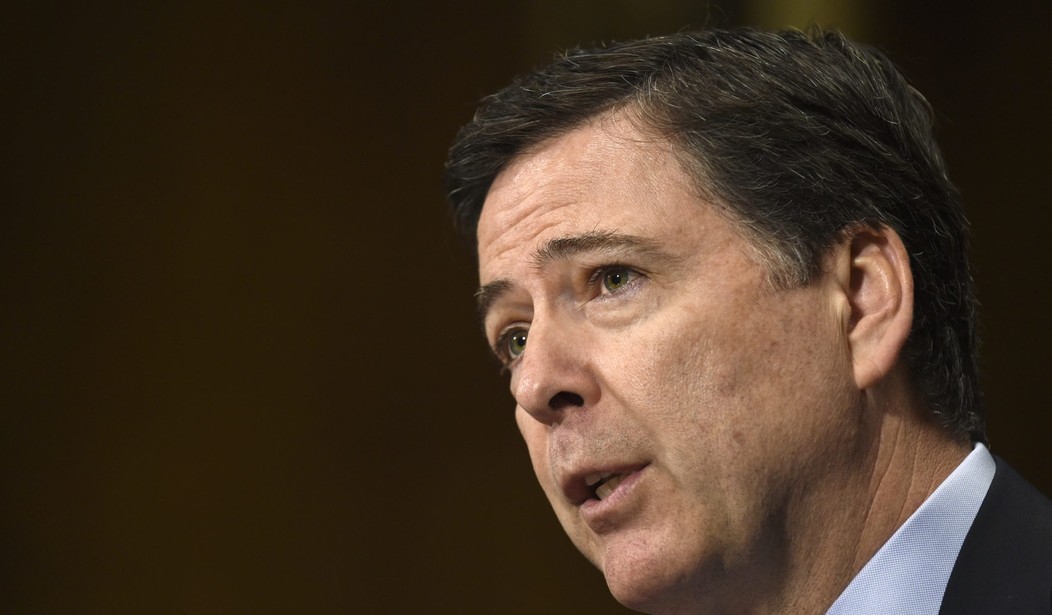After masterfully marshaling facts that showed Hillary Clinton was grossly negligent in mishandling the nation’s defense secrets – i.e., after demonstrating that she was patently indictable for a felony violation of federal law – Federal Bureau of Investigation Director James Comey recommended against prosecution. His rationale is even more difficult to justify on close examination than it appeared at first blush.
Director Comey contends that “no reasonable prosecutor” would bring a case due to the former Secretary of State’s purportedly benign intent. In point of fact, her intent – besides being very far from benign – is largely irrelevant: the criminal statute at issue, Section 793(f) of the federal penal code, merely requires proof that the defendant was grossly negligent – or, as Comey put it, “extremely careless.” But more importantly, a reasonable prosecutor considering charges would not myopically obsess over Clinton’s state of mind. Far more weighty in the exercise of prosecutorial discretion would be two factors Comey did not cite at all in his presentation: (a) Congress’s purpose in criminalizing the grossly negligent mishandling of classified information, and (b) the harm actually done to the United States which, viewed from the perspective of the intelligence community underwritten by 50 billion American taxpayer dollars annually, was surely immense.
Let’s dispense with the matter of Mrs. Clinton’s intent – a side issue that Director Comey magnified into the dispositive issue. Unlike most criminal statutes, the felony of grossly negligent mishandling of classified information does not call for prosecutors to prove that a defendant intended the harm done. It merely requires proof of gross negligence – which is no different from what Comey compellingly demonstrated was Clinton’s “extreme carelessness” in mishandling national defense secrets.
Consider an analogy: a car passenger tragically dies because the driver is texting behind the wheel. There is no need in the negligent homicide case to prove (and indeed, no possibility of proving) that the driver intended to cause harm to the passenger. The driver is guilty because she purposely engaged in the reckless conduct – texting while driving – that risked the grave and easily foreseeable danger.
Similarly, Mrs. Clinton’s may not have intended to cause harm. In fact, let’s for argument’s sake concede Comey’s premise that she did not intend to make classified information vulnerable to hostile hackers when she purposely caused its transfer from the government’s secure server system to her own woefully non-secure system. Still, the felony statute at issue does not call for proof that she intended the harm done to the United States. Prosecutors need only prove what Comey so ably outlined: Clinton purposely engaged in the reckless behavior – the installation and use of an impermissible and amateurishly non-secure, non-government server system – that made harm to the United States virtually inevitable.
Still, I want to move beyond the lawyerly parsing of mens rea to a more curious aspect of Director Comey’s reasoning. The director implausibly claimed that no reasonable prosecutor would charge Clinton based on the facts uncovered by the FBI. This, as he acknowledged, was not his call to make – prosecutorial discretion is ultimately exercised by the Justice Department lawyers, not the FBI. Yet, as a highly accomplished former prosecutor, Comey offered what he intimated was an exhaustive list of factors any “reasonable” prosecutor would weigh; then, upon weighing them, he determined that they decisively militated against indictment.
When we more closely examine Comey’s list of factors, however, we find that they are far from exhaustive – instead, they are an exhaustive parsing of a single, largely irrelevant factor: Clinton’s state of mind. More importantly, the list omits factors any reasonable prosecutor would weigh far more heavily.
To be more precise, the director’s seemingly extensive list of factors just restates, again and again, the purported significance of Mrs. Clinton’s intent. Here’s the list in a nutshell: “the strength of the evidence especially regarding intent”; the context in which a person acted; whether the mishandling was “clearly intentional and willful”; whether the amount of materials involved created “an inference of intentional misconduct”; whether there were “indications of disloyalty to the United States”; and whether there were “efforts to obstruct justice” (i.e., indicia or corrupt intent).
It is a credit to Comey’s skill as a lawyer that he can make a summer of a single swallow. But his repetition of a largely irrelevant consideration cannot paper over his omission to the two things that any reasonable prosecutor, faced with a charging decision, would analyze:
First, would a prosecution, based on the facts uncovered, further Congress’s purpose in criminalizing the conduct?
Second, what harm was done?
The first consideration is an easy one. In criminalizing the grossly negligent mishandling of classified information, Congress sought to accomplish two objectives: (a) the protection of national security; and (b) the admonition to officials privileged with access to classified information that they have a high obligation to protect the secrecy of that information. Obviously, a prosecution of Mrs. Clinton on the facts uncovered by the FBI – as Director Comey showed, her extreme carelessness in transmitting classified information and conducting State Department business over a palpably unsafe communications system that was virtually certain to have been penetrated by hostile hackers – would further Congress’s purposes in enacting Section 793(f).
The second consideration brings us to a subject on which Comey was strangely silent: the harm Clinton’s actions have done.
In notably measured terms, Comey conceded it was “possible” that Mrs. Clinton’s woefully non-secure system was hacked. Yet the director made no reference to the consequent damage-control efforts our intelligence agencies must have had to undertake. As a law-enforcement official in the business of proving facts beyond a reasonable doubt in court, Comey may indulge the fiction that, until conclusively proven, it is merely “possible” that Clinton caused top secret information to fall into the hands of foreign intelligence services, terrorist organizations, and other hostile actors. The intelligence community has no such luxury. They must assume the obvious: the compromise of our defense secrets is a certainty.
Let’s remember what Director Comey did acknowledge:
With respect to potential computer intrusion by hostile actors, we did not find direct evidence that Secretary Clinton’s personal e-mail domain, in its various configurations since 2009, was successfully hacked. But, given the nature of the system and of the actors potentially involved, we assess that we would be unlikely to see such direct evidence. We do assess that hostile actors gained access to the private commercial e-mail accounts of people with whom Secretary Clinton was in regular contact from her personal account. We also assess that Secretary Clinton’s use of a personal e-mail domain was both known by a large number of people and readily apparent. She also used her personal e-mail extensively while outside the United States, including sending and receiving work-related e-mails in the territory of sophisticated adversaries. Given that combination of factors, we assess it is possible that hostile actors gained access to Secretary Clinton’s personal e-mail account.
Remember, the director said any reasonable prosecutor would consider “the context of a person’s actions.” Well, this is the context – aptly described by Comey as “evidence that [Clinton and her colleagues] were extremely careless in their handling of very sensitive, highly classified information” – in which Clinton’s cavalier disregard for America’s defense secrets took place. As Director Comey recounted:
For example, seven e-mail chains concern matters that were classified at the Top Secret/Special Access Program level when they were sent and received. [ACM note: these are among the nation’s most closely guarded secrets, often involving extraordinarily valuable informants and crucial intelligence collection methods.] These chains involved Secretary Clinton both sending e-mails about those matters and receiving e-mails from others about the same matters. There is evidence to support a conclusion that any reasonable person in Secretary Clinton’s position, or in the position of those government employees with whom she was corresponding about these matters, should have known that an unclassified system was no place for that conversation.
In addition to this highly sensitive information, we also found information that was properly classified as Secret by the U.S. Intelligence Community at the time it was discussed on e-mail[.]… None of these e-mails should have been on any kind of unclassified system, but their presence is especially concerning because all of these e-mails were housed on unclassified personal servers not even supported by full-time security staff, like those found at Departments and Agencies of the U.S. Government – or even with a commercial service like Gmail.
So what is the extent of the damage done to national security by this egregious misconduct? It is potentially so severe as to be incalculable, for the reasons I outlined at National Review earlier this year – long before we had Comey’s startling report of Clinton’s recklessness:
In The Snowden Operation: Inside the West’s Greatest Intelligence Disaster, Edward Lucas, a longtime Economist senior editor and student of intelligence operations, explains in vivid detail how “the mere whiff of a breach acts like nerve poison on intelligence agencies.”
Take just a single document that contains a defense secret, or conveys the method or source by which secrets are acquired. If the agency discovers the document has been lost, or comes to “believe an unauthorised person has had access to it, assumptions must be of worst-case scenarios.” What could a hostile government or terror network do with that information? Will they kill an intelligence agent who has been outed? What about operatives the agent has been running — who must then be pulled out to avoid arrest, or worse? Even if our spies are safe, their operation must be considered blown, along with arrangements on which the operation relied — cooperating businesses, bank accounts, safe houses, drop boxes, etc.
Then there is the matter of when the compromise occurred. Can we be sure of the time? Remember: It is worst-case analysis. If the agency can’t be sure, it must assume the earliest point. Does that mean the agency has been victimized by counterintelligence? Did the hostile government or terror network feed the agency misleading information and then monitor the results? Is the precious intelligence the agency thought it was collecting actually corrupted? Have security policies based on the intelligence actually endangered us? Have they been expensive wastes of money and effort?
As Lucas notes, “The answers to these questions may be ‘no.’ But an experienced team of counter-intelligence officers must ask them, find the answers, check and double-check. The taint of even a minor breach must be analysed, contained, and cleaned.”
Bear in mind, we’re still talking about a single breach. How about two? The corrective measures quickly become nightmarish. The danger metastasizes if the breaches come from different components of the intelligence community. And the challenge cannot be wished away by telling oneself that the compromised information is not all that significant. A document that seems harmless enough can be devastating when combined with another — read together they may reveal a collection technique that is of far greater consequence than the information on the page.
As Lucas elaborates,
Multiple breaches increase the problem exponentially. Each bit of compromised information must be assessed not only on its own, but in relation to every other piece of data. As the numbers mount, the math becomes formidable. Four bits of information have 24 possible combinations. Seven have 5,040. Ten have more than three million.
Again, Director Comey’s report did not address the damage done to American intelligence operations by Mrs. Clinton’s “extreme carelessness.” In some ways, this is understandable: The damage done to intelligence operations cannot be described in detail without revealing the operations and potentially doing even more damage. That, however, does not alter the fact that, to a reasonable prosecutor, the damage Clinton has done is far more important than her intent in doing it. Any reasonable prosecutor would demand a general accounting of the damage-control forced on our intelligence agencies by Clinton’s gross negligence.
Bottom line: Mrs. Clinton’s prosecution would be entirely consistent with Congress’s aim to protect national security by criminalizing grossly negligent mishandling of classified information. And it certainly appears that Mrs. Clinton’s actions were profoundly damaging. To a reasonable prosecutor, that would matter. A lot.








Join the conversation as a VIP Member